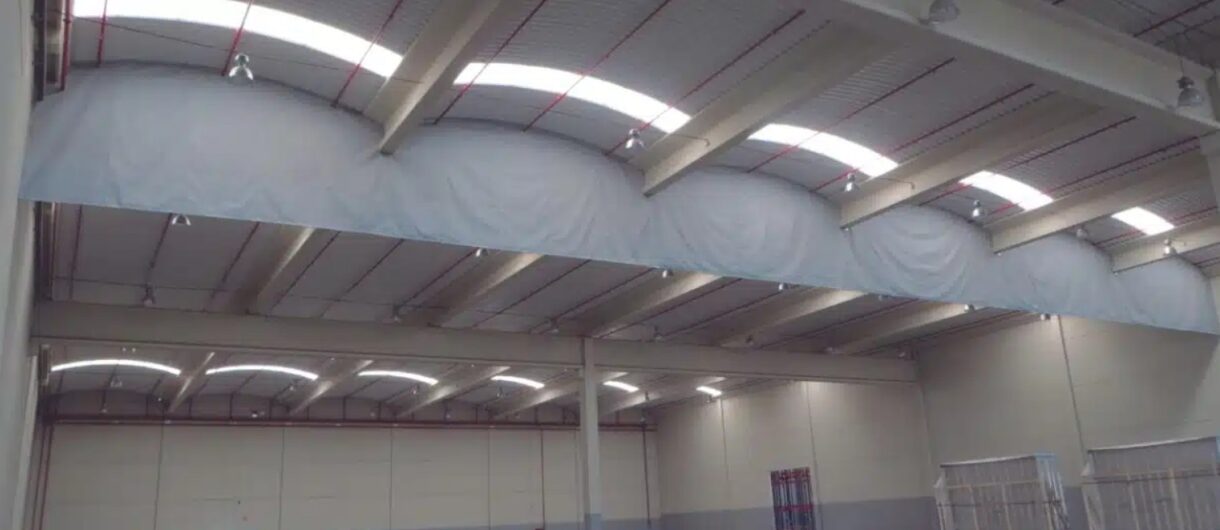
How smoke curtains enhance the active protection of SHEV systems
Smoke curtains or barriers, as part of a complete temperature and smoke evacuation control system, must be correctly combined with the other PCI systems installed throughout a fire protection project.
Smoke is a major risk factor in a fire, and therefore, effective control through the combination of the right systems can make a difference.
In previous articles, we have defined what an SHEV is, but today we want to focus on the interaction between smoke vents and curtains in containing and channeling smoke during a fire.
The SHEV as an active protection installation
Smoke is a risk element, just as important as the flames during the development of a fire. This is where SHEV plays an important role in active protection, ensuring the safety of people and the building’s structure due to its ability to control smoke, limiting its extension to a specific area in a fire sector.
What makes up an SHEV system?
The Temperature and Smoke Evacuation Control Systems (SHEV), known in the U.S. as smoke and heat ventilation systems, consist of a series of openings, also called ventilators or exutories, which are usually installed on roofs for the extraction of smoke and gases produced by combustion during a fire.
These exutories have an active role, but also play a passive role regarding energy efficiency, lighting, and natural ventilation.
In addition, an SHEV installation also considers smoke barriers as a key component. When interacting with the ventilators, these curtains enhance their effectiveness and optimize their operation.
How do curtains and exutories interact to ensure smoke control?
The sizing of the aerodynamic smoke evacuation surface is governed in Spain by the UNE-EN-12101-1 standard, “Specifications for smoke control barriers”. But the calculation and design of SHEV systems follow the UNE 23585:2017 standard, and their installation, operation, and maintenance are covered by the UNE 23584:2008 standard.
By installing the two key elements of an SHEV system, exutories and curtains, we guarantee the creation of a smoke-free layer above the level where the fire is occurring, maintaining the average smoke temperature at levels that allow and facilitate the work of fire-fighting teams.
On the other hand, in an SHEV installation, it is extremely important to consider the thermal gradient of the space being covered, which can vary during the fire due to the fire’s own convection forces, affecting its vertical distribution and even causing stratification or unexpected movements of the smoke.
Since each exutory has limited smoke evacuation capabilities, controlling the thermal gradient becomes crucial, as smoke tends to spread throughout the available surface, gaining thickness. This is why compartmentalizing, through smoke curtains, the fire sectors promotes that thickness in a confined space, preventing the smoke from spreading further and facilitating the work of the exutories.
Additionally, the installation of curtains also protects the goods contained in the facilities, especially in the logistics sector, where many products affected by smoke lose their value and cannot be sold. Hence, the importance of compartmentalizing spaces, minimizing the number of products that come into contact with smoke.
Given the increasing trend to remove curtains in performance-based projects, we must indicate that there is no one-size-fits-all strategy in the design of an SHEV, and each project must be studied specifically to determine whether the presence of smoke curtains is more or less efficient. Nevertheless, our conclusion is that, for most cases, removing curtains clearly reduces the level of fire safety in the projects.
At Tecnitex, we specialize in addressing fire protection projects through the installation of fire curtains and smoke barriers as a fundamental part of SHEV systems. Consultants, manufacturers, installers, and maintenance personnel— we handle each phase of curtain installation, accompanying the client throughout.
If you need advice on any of these solutions, our team can inform, advise, and provide you with all the details you need. Shall we talk?